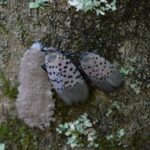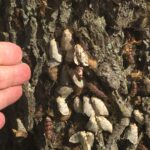As emerald ash borer reached its highest populations throughout the landscape in Indiana, Purdue University, partnered with other organizations, helped to spread several messages intended to engage the public in helping limit the movement of the insect. Readers may recall one such message in the form of bumper stickers with the phrase, “Don’t Move the Firewood, It Bugs Me!”. While this message is approaching 20 years old, its importance is no less now than it was at the height of the invasion. Firewood was identified as a major vector for emerald ash borer, and much of the insect’s expansion throughout the state was facilitated by its transport through susceptible areas. Invasions of exotic forest pests are ongoing in Indiana, and many species use trees as a source of nutrition, oviposition substrate, and as shelter, meaning they can be found in firewood. Managing the use and transport of firewood can greatly assist in preventing the spread of many invasive species, such as spongy moth and spotted lanternfly.
Understanding how firewood becomes a vector for invasive insects is an important first step in limiting their movement. During the height of the emerald ash borer invasion, dead ash trees would be cut as they became unsightly, brittle, and potentially dangerous, and wood would be used firewood. This firewood would also be infested, often carrying eggs, larvae, and developing pupa of emerald ash borer. It would then be sold and transported, often to places like state parks and private woodlands that contained plenty of potentials new host trees. Any eggs or pupae left in firewood that sat through the winter would hatch out, spreading new emerald ash borers into yet another landscape. This process is much the same for several insect species. For example, spotted lanternfly will lay egg masses on trees, typically covered in a protective secretion that acts as an effective camouflage. These egg masses can easily be mistaken for mud, and it’s not unusual to miss their presence altogether. Just like with emerald ash borer, firewood with egg masses can be transported to sensitive areas, introducing spotted lanternfly to a new habitat. Unlike emerald ash borer, however, many of our invasive species of concern are significantly more generalist in their host preferences.
Improving one’s knowledge of invasive forest pests improves the ability to limit their movement, especially when it comes to the use of firewood. Like with any integrated pest management plan, understanding the biology and ecology of an insect will help control it most effectively. Emerald ash borer specialize in ash, so the chances of them being present in other species is exceedingly rare, if ever. Spotted lanternfly is able to lay egg masses on virtually any surface, but in Indiana, they are most commonly associated with tree-of-heaven near railroad tracks. If that combination of factors is not present, your chances of encountering them is low, and the egg masses are on the surface, so they can be removed. Spongy moth is limited to northern Indiana and feed primarily on oak species, and their egg masses are easily seen. These are just a few examples of how knowledge of these insect’s life cycle can enhance one’s ability to identify their presence.
Even with all the information above, the most important thing you can do is use firewood where it has been cut. If you plan to go camping in another county, check ahead with local firewood sellers and determine where it was cut. According to the Nature Conservancy and the Don’t Move The Firewood campaign, so long as firewood was cut within 50 miles of where it will be burned, it should be relatively safe and not transport an invasive species beyond its infestation site. They also emphasize planning ahead and checking if there are any local rules or laws governing the use of firewood in the area you plan to use it. If it’s not possible to get locally-source firewood, consider purchasing USDA-APHIS certified heat-treated firewood, which can be easily identified by the certification seal. Check out the resources below for more information on the use of firewood and help limit the movement of these exotic pests!
Resources:
Don’t Move the Firewood Campaign website:
https://www.dontmovefirewood.org/
ReportINvasive website:
https://ag.purdue.edu/reportinvasive/
- Photo credit: Spongy moth with egg masses, Jeff Burbrink; Spotted lanternfly with egg mass, Elizabeth Barnes
- Photo credit: Spongy moth with egg masses, Jeff Burbrink; Spotted lanternfly with egg mass, Elizabeth Barnes

